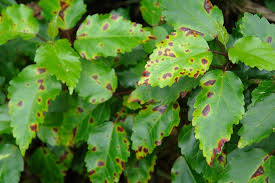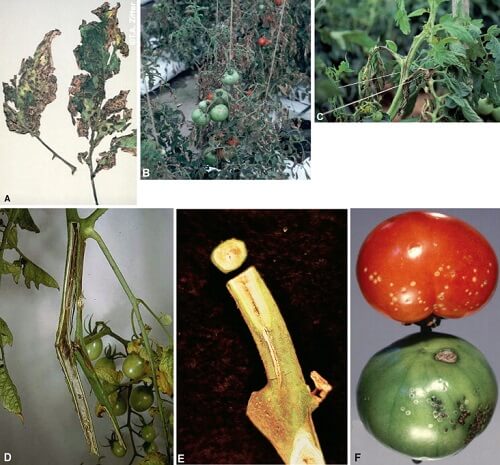Bacterial diseases in plant
Pathogenic bacteria can cause numerous serious diseases in crops and vegetables. They don't enter the plant directly through tissue instead they penetrate through wounds or stomata or hydathodes. Wounds are the result of damage caused by insects, pathogens, and handling during operations such as picking and pruning. Bacteria only become active and cause disease when the environmental condition is in favor of them to divide and reproduce. Bacteria have the ability to multiply in large colonies. Some factors like high humidity, high moisture poor air circulation, stress caused by over-irrigation, water deficit, irregular altering conditions, poor soil health, and excess or deficient nutrients required by the plant to grow. Bacteria diseases can be classified into four broad groups depending on the severity of damage to the plant tissue and the severe symptoms that these diseases cause. The symptoms include vascular wilt, necrosis of the leaf, leaf curl, soft rot, and tumors. Vascular wilts result from an invasion of the vascular system of plants by bacterial infection. Some common examples of vascular wilts are sweet corn, alfalfa, tobacco, cucurbits and tomato, and black rot of crucifers. Necrosis is a cell injury resulting from premature cell death. The pathogen can cause necrosis by releasing toxins in the plant. The symptoms are the formation of leaf spots, cankers, or stem blights. The pathogen can cause Soft rot diseases by secreting enzymes that are capable of degrading cell walls and membranes thus destroying the composition and texture of plant tissue. Hence plant tissue becomes macerated i.e. Soft and has fluid. Soft rot is commonly found on vegetables like potatoes, eggplant, carrot, squash, and tomato. Tumor diseases are caused by a pathogen that facilitates the uncontrolled division of plant cell leading to into tumor cell that forms abnormally large bulbous structure. Generally, it is difficult to detect which pathogen has affected the plant. 
Transmission and infectionFor a bacterium to infect a plant, it is important for the bacteria to first invade the plant tissue and divide. The bacteria enter plants through wounds, scrapes, lesions, caused by adverse weather conditions, humans, machines, other organisms, and nematodes or through natural ways such as stomata, lenticels, hydathodes, nectar, and leaf scars. Humans also let bacteria into plants through cultivation, grafting, pruning, or contact of healthy plants with diseased plants. Animals like insects and mites can also transmit disease to plants. When the conditions are unfavorable for the growth and reproduction of the bacteria, they remain inactive or stay inside the plant tissue. Temperature and moisture are the key influencers of bacterial diseases in plants. However, only a few degrees of change in temperature can lead to the development of bacterial disease. Most of the time, moisture act as an important carrier for an infection to develop on the plant surface. Survival of the bacteriaBacterial pathogens survive in either soil or crop debris, seeds, and other plant parts. Bacterial diseases are grow best on weed crops. They act as storage reservoirs for bacterial diseases. They transmit through infected seeds, propagating seeds and crop waste, through water spray and rain. They also transmit through equipment that gets contaminated by worker's hands. Spread of bacterial diseaseThe spread of bacterial disease is also favored by overhead irrigation. The development of some bacterial diseases is also favored by hot, moist weather. While some of the pathogens are favored by cold, moist weather. Management of bacterial diseases in plantsThe management of disease aims straight to favor the growth of the host plant and its development while attacking the stages of the pathogen where they remain vulnerable. Also, to prevent or restrict the development of the pathogen. The key factors to manage bacterial diseases in plants include.
CONTROL1. Host resistance by genetics
2. Cultural methods
3. Sanitation
4. Chemical applications
4. Using biological techniques
5. Implementation of Government regulations
Some pathogen that cause infection in plants1. Causative agents - Pseudomonads syringae pv. Lachrymans Distribution - spread through the world. Symptoms This occur mainly in most cucurbits but it occured as a great significance on cucumbers. At beginning, foliar symptoms appear as small, the water absorbed areas on the underside of the leaf, which later develops as an angular appearance due to restriction by the small leaf veins. Under humid conditions, a milky latex may appear from the water soaked areas on the lower leaf surface. As the latex dry out, a white outer surface appear at the end when the latex get soaked up. The spots on leaves appear brown and may develop yellow haloes. The center of the spot may eventually degrade, giving the tattered appearance. Infection on stems, petioles and fruits started appearing as water soaked spots, which give out milky exudates under the humid conditions and eventually give out a white crust surface. Infection of young fruit may lead to deformation of fruit t maturity. Infected fruit may develop secondary soft rots. Common bacterial diseases and crops that get affected by these pathogens 2. Causal agent - Acidivorax citrulli Distribution - Worldwide Symptoms - different symptoms appear in different fruits Watermelon At initially, the disease may first appear on cotyledon as irregular water socked tissue which later turns into brown black scraps. On young growing leaves, small diagnostic brown lesions may appear on leaf veins. Other symptoms may also occur on seedlings including chlorosis, sharp-pointed lesions veinal or interveinal necrosis and damping off. In the field, these lesions may appear on the veins of leaves and that eventually dry and may appear as reddish brown to black lesion. Bulbous blotches may get develop on the tissue of fruits in association with soil. They often associated with fungal infection. As the disease spread, infected areas on the fruit may break or rupture releasing the content. Control The main focus is to prevent the spread of the disease than curing the plant. The control measures include: Use seed that is healthy and resistant to Acidovorax citrulli tested with a valid seed health testing method. Introduce crop residues to enhance the breakdown of debris and other healthy seedlings. Crop rotation for a minimum of three years must be done and implement a sanitation program for better cultivation and crews. The use of copper-based products in transgenic plants and throughout the growing season can help to reduce disease outbreaks and their spread. 3. BACTERIAL FRUIT ROTS Causal agents - Pectobacterium carotovorum subsp. carotovorum, Pseudomonas spp. and several other bacteria cause Soft rot diseases in fruits. Pantoea ananas cause brown rot diseases in plants Distribution - all across the world Symptoms Soft rot appear as a water soaked tissue of the fruit which develops very quickly to complete softening and result into the collapse of fruit tissue. Brown spots has been seen on cantaloupe and honeydew types of melon. The lesion of these diseases are generally smooth, firm nd yellow to brown in color. Lesion may appear on the epidermis and extend upto one to two millimetres. Symptoms are less common on netted types. Condition for disease development Soft rot appear most commonly under warm and wet or moist conditions. Other diseases like angular leaf spots, blossom end rot can lead a soft rot bacteria to enter fruit. Soft rots cab lso develop into wounds created during harvest or packaging of fruits. Brown spot may also develop similarly like bacterial soft rot. Brown spot develops under similar conditions as bacterial soft rot. Control Avoid bruising, tearing or punching or other mechanical destruction to fruit during harvest and packing. The application of chlorinated fruit sprays in store or packing house has been shown to reduce the chance of soft rot. Store fruits at an optimum temperature and humidity to prevent condensation on the surface of fruits. 4. BACTERIAL LEAF SPOT OF CUCURBITS Causal agent - Xanthomonas cucurbitae Distribution - Across the world Symptoms The symptoms arise on the dorsal side of the leaf as water-soaked scrapes, that appear mostly angular in shape but sometime it might appear round in shape. Leaf veins do not usually appear to show the shape of the lesion in all cases. Yellow spots appear on the upper surface of the leaf. These yellow spots eventually change to brown or may become translucent retaining the bright yellow halo. The foliar symptoms may appear similar to those of angular leaf spot caused by Pseudomonas syrinae. These foliar leaf spots are caused by Xanthomonas cucurbitae are smaller at initial than angular leaf spots. The fruit may also bear lesions of different sizes and appearances. By maturation, these lesions accumulate enough amount of moisture surrounding it. Symptoms generally begins with small, rounded, deep lesions with center surrounded by dark nimbus-like scab. By progression, lesions may become deep leading to the breaking of the rind and eventually the fruit rot in the storage house. Condition for Development of disease The pathogen Xanthomonas cucurbitae is seen to be associated with seed and can overwinter in crop debris. The infection is promoted by a high temperature of about 25-30°C and high relative humidity. The disease occurs mainly in heavy rains, dew, or excess irrigation. Control Avoid the use of over-irrigation. Avoid entering the field when the plants are wet. The application of copper-based sprays before the infection may help to restrict the spread. Destroy infected crop debris by either plowing into the soil or burning the crops. Crop rotation for at least two years.
Next TopicBacterial Pneumonia
|
 For Videos Join Our Youtube Channel: Join Now
For Videos Join Our Youtube Channel: Join Now
Feedback
- Send your Feedback to [email protected]
Help Others, Please Share










